The NBA Cup Officially Returns, Signaling the Highly Anticipated Comeback of One of Basketball’s Most Exciting and Competitive Tournaments.
The NBA Cup’s return marks one of the most talked-about developments in professional basketball in recent years, a revival that fans, players, and league officials have been buzzing about since whispers of its comeback began circulating. While the NBA Cup is a relatively new addition compared to the long and storied history of the NBA Playoffs and Finals, its reintroduction into the league calendar is a sign that the NBA is committed to expanding the variety and excitement of the season. This is not just another basketball event — it’s an opportunity for teams to showcase themselves in a high-energy, winner-takes-all atmosphere that blends the competitive intensity of playoff basketball with the novelty and unpredictability of a mid-season tournament. The fact that it’s coming back is more than just a scheduling update — it’s a bold move to keep the NBA season fresh, thrilling, and constantly evolving.
When the NBA first launched the Cup, there were mixed reactions. Some fans immediately embraced the concept, seeing it as a chance to inject fresh storylines and a different kind of urgency into the regular season. Others questioned whether players would take it seriously or if the competition would simply become another exhibition-style showcase without real stakes. But as the games unfolded in its inaugural run, those doubts began to fade. Players fought hard, coaches game-planned with playoff-like precision, and the atmosphere in arenas had that special buzz reserved for moments when something meaningful is on the line. The return of the NBA Cup is fueled by those memories, with league officials pointing to the strong television ratings, social media engagement, and, perhaps most importantly, the competitive fire it lit under both established stars and emerging talent.
The beauty of the NBA Cup lies in its format. Unlike the grueling, months-long playoff grind, the Cup operates as a compact, high-intensity tournament in the middle of the season. Every possession matters, every game could be your last in the chase for the trophy, and there’s no room for off nights or slow starts. For players, it’s a chance to compete for a different kind of hardware. For teams, it’s an opportunity to galvanize chemistry, test their mettle against top-tier opponents, and create momentum heading into the stretch run of the regular season. And for fans, it’s an injection of high drama right when the regular season can sometimes feel like a long, steady march toward the playoffs.
The league’s decision to bring it back wasn’t made lightly. Commissioner Adam Silver and the NBA’s competition committee spent months reviewing feedback from players, coaches, general managers, and even fans before giving the green light. They analyzed what worked during the first iteration — the exciting finishes, the intense semifinal rounds, the way young players used the stage to make a name for themselves — and they also examined what could be improved. This time around, the NBA has tweaked scheduling to reduce player fatigue, adjusted incentives to make participation even more rewarding, and expanded marketing to make sure fans understand the stakes and structure of the tournament. The goal is simple: make the NBA Cup a tradition that fans eagerly anticipate every year, the way soccer fans worldwide cherish mid-season cup competitions in their favorite leagues.
Speaking of incentives, the league has sweetened the pot for both players and franchises. The prize money on the line has been increased, ensuring that even role players on the winning team receive a life-changing bonus. Beyond cash rewards, there are also bragging rights and legacy considerations — the chance to be etched in NBA history as a Cup champion, something that could grow in prestige over time. Some analysts believe that if the NBA Cup continues to return year after year, it could eventually become a major career milestone for players, much like winning a conference title or earning Finals MVP honors.
One of the most intriguing aspects of the NBA Cup’s return is the impact it could have on team dynamics and strategy. Coaches may use the tournament to experiment with rotations, test their team’s mental toughness, and simulate playoff-style preparation. At the same time, certain franchises could use a strong Cup showing to validate their roster construction or spark a turnaround in a struggling season. A Cinderella run in the NBA Cup could propel a fringe playoff contender into a legitimate threat, and that potential for surprise is exactly what makes tournaments so captivating.
For fans, the return of the Cup also means more meaningful basketball during a part of the calendar that can sometimes feel overlooked. The early-to-mid portion of the regular season often struggles to match the energy of the playoffs, but the Cup changes that dynamic entirely. Suddenly, December or January games can carry the weight of elimination stakes. Every shot, every defensive stop, every late-game decision is magnified. It’s the kind of energy that makes casual fans tune in and die-hard supporters live and breathe every moment.
The players themselves have been vocal about the tournament’s return. Stars like LeBron James, Stephen Curry, Giannis Antetokounmpo, and Kevin Durant have all spoken in interviews about how competition is in their DNA, and any opportunity to play for a title — no matter the format — gets their competitive juices flowing. Younger players, too, see the Cup as a chance to fast-track their reputations. Imagine a second-year guard going toe-to-toe with an All-NBA veteran in a nationally televised elimination game — one incredible performance could change the trajectory of an entire career.
Of course, with any ambitious initiative, there are still skeptics. Some fans worry that the Cup could distract from the ultimate goal of winning the NBA Championship, while others question whether teams might prioritize resting stars to preserve their health for the postseason. The league has attempted to address those concerns through careful scheduling and by aligning Cup games with regular-season matchups, ensuring that no extra games are tacked on unnecessarily. In fact, one of the key features of the tournament is that it blends seamlessly into the regular season — every Cup game counts toward the standings, meaning no team can afford to take it lightly without jeopardizing their playoff positioning.
The marketing push for the Cup’s return has been as aggressive as it is creative. The NBA has released cinematic promotional trailers featuring dramatic voiceovers, slow-motion highlight reels, and shots of the Cup trophy gleaming under the arena lights. Social media is flooded with countdowns, team hype videos, and even behind-the-scenes glimpses of how the tournament will unfold. Merchandise featuring the NBA Cup logo is already hitting stores, from jerseys to snapbacks, signaling that the league is fully committed to making the event not just a basketball competition but a cultural moment.
From a global perspective, the NBA Cup also plays a significant role in the league’s mission to expand its international appeal. The tournament’s condensed, high-stakes format is perfect for drawing in new fans from countries where soccer cup competitions are already wildly popular. The idea of knockout games and surprise upsets is universally thrilling, and the NBA is betting that this familiarity will help basketball grow even further on the world stage.
Looking ahead, the NBA Cup’s return could be the first step toward an even bigger transformation of the league calendar. Some insiders speculate that if the Cup proves to be a consistent success, the NBA could expand it, perhaps adding international games, multiple host cities, or even a Champions League-style format where top teams from other leagues around the world are invited. While those ideas remain speculative, the fact that people are already discussing them shows just how much potential this tournament has to evolve into something iconic.
Ultimately, the NBA Cup’s comeback is about more than just games and trophies. It’s about the league’s willingness to innovate, to take risks, and to prioritize entertainment in a way that resonates with modern audiences. It’s about giving players new challenges, fans new reasons to cheer, and the sport of basketball new avenues to grow. And when the first tip-off of the Cup’s return happens, it will be the start of something bigger than just a game — it will be the continuation of an idea that has the power to redefine how we experience an NBA season.
Whether you’re a skeptic waiting to be convinced or a believer already counting down the days, there’s no denying that the return of the NBA Cup has captured the attention of the basketball world. It’s a reminder that sports, at their best, are about competition, unpredictability, and the moments that make you jump out of your seat. The NBA Cup delivers all of that in concentrated doses, and now, it’s back to do it all over again. The only question that remains is simple: who will be the next team to lift that gleaming trophy and etch their name in this growing chapter of NBA history? Whoever it is, they won’t just be winning a tournament — they’ll be making history in an event that’s quickly becoming one of the most exciting traditions in the sport.



